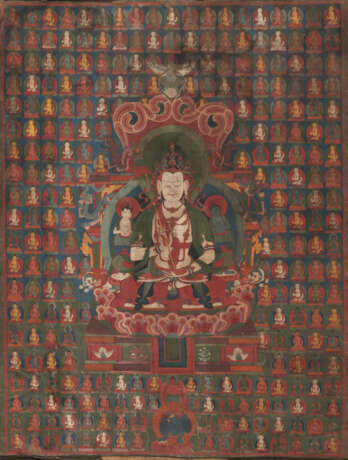ID 973566
Лот 609 | Sangpo Bumtri - einer der vier Transzendenten Hüter der Bön-Tradition
Оценочная стоимость
€ 900 – 1 500
88 x 68 (130 x 71) cm
"Bön gilt als Tibets älteste spirituelle Tradition und spielte als die ursprüngliche Quelle der tibetischen Kultur eine bedeutende Rolle bei der Prägung von Tibets einzigartiger Identität.“ (Tenzin Gyatso, der 14. Dalai Lama aus seinem Vorwort in "Wonders of the Natural Mind" von Geshe Tenzin Wangyal Rinpoche, 2000)„ Die Bön-Tradition wird für gewöhnlich bei dem Königreich Zhang Zhung verortet das den Heiligen Berg Kailash umgab, das bis zur Regentschaft des tibetischen Königs Songtsen Gampo im siebten Jahrhundert, rund um den Berg Kailash, und in der Region westlich von Tibet bestand. Viele Gottheiten, besonders aus der Tradition der Nyingma Schule finden Entsprechungen im Bön-Pantheon. Sangpo Bumtri wird als der „Schöpfergott der Bön“ bezeichnet. Zusammen mit Satrik Ersang (Sherab Chamma), Tonpa Shenrab und Shenlha Ö dkar ist er einer der vier transzendenten Hüter. Es heisst er habe „weder Augen zum Sehen, noch Hände zum Halten, noch Ohren zum Hören, noch Nase zum Riechen, er habe nur seinen Geist“. Er besitzt einen silberweißen Körper. Sangpo Bumtri ́s Körper ruht auf einem Sonne-Mond-Lotos, auf einem altarähnlichen Thron mit stark ausschwingenden Voluten über seinem Körper. Sein Haupt ziert eine fünffache Krone. Er ist mit Schmuck angetan und trägt seidene Kleider. Nach der buddhistischen Trikaya-Lehre befindet er sich im Schmuckkörper des Samboghkaya. Die rechte seiner Hände hält auf einem langen Stab einen dreifarbigen Schirm, als eine Art Siegesbanner, die linke liegt meditativ im Schoß. Flankiert wird die Gottheit von zwei Begleitern in weißer und blauer Farbe. Beide zeigen die Geste des Lehrens. Umgeben wird Sangpo Bumtri von mythologischen Tieren. Über seinem gewundenen Thronschmuck erscheint Garuda, der Herr der gefiederten Tiere, links und rechts darunter ein braunfarbenes Meerungeheuer - Makara, darunter ein männlicher und ein weiblicher Glücksdrachen, Perlen in ihren Klauen haltend, und zu unterst links und rechts neben dem Thron liegen weiße Schneelöwen vor deren Maul je ein händefaltendes Menschenwesen kauert. Emanationen der Gottheit, alternierend in den Farben Weiß, Blau, Gelb, Rot und Grün umrahmen die zentrale Gottheit, wobei die Reihung der farbigen Emanationen eine diagonal verlaufende Struktur über das ganze Bild ergeben. Ganz unten in der Mitte, unterhalb einer rotfarbenen Gottheit (Tönpa Shenrap?), erscheint ein kraftvoller Schützer der Bön-Religion, der „Überwinder aller Feinde“ - Welsé Ngampa (yab-yum). Er trägt neun Häupter, teils Tierköpfe, und hat achtzehn Arme und zwei Beine mit denen er auf zwei Hindergeistern über einem Sonnenlotos steht. In seinen vorderen Händen hält die Gottheit einen Ritualdolch. In den Nischen seines Throns befinden sich zwei weißgefiederte Garudas. Tempera auf Baumwollgewebe, originale trapezförmige Fassung an den Schmalkanten; Rückseite: Mehrzeilige Inschrift in schwarzer Tusche; (meist Mantras, nicht übersetzbar).
| Категория аукционного дома: | Искусство Азии |
|---|
| Категория аукционного дома: | Искусство Азии |
|---|
| Адрес торгов |
Nagel Auktionen GmbH Neckarstrasse 189 - 191 70190 Stuttgart Германия | ||||||||||||||
|---|---|---|---|---|---|---|---|---|---|---|---|---|---|---|---|
| Предосмотр |
| ||||||||||||||
| Телефон | +49 (0)711 649 690 | ||||||||||||||
| Факс | +49 (0)711 649 69696 | ||||||||||||||
| Комиссия | 29,5% | ||||||||||||||
| Условия использования | Условия использования | ||||||||||||||
| Часы работы | Часы работы
|




